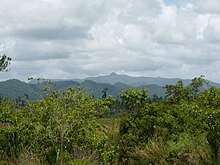Maya Mountains I am a mountainous cantena in district of Toledo (Southern Belize).
To know
Those interested in today's forms of Mayan culture will find an excursion to the villages scattered in the mountains behind Punta Gorda full of natural attractions
The main attraction is constituted by the villages (about thirty), inhabited by Mayan people and surrounded by lush vegetation, crossed by numerous rivers and streams.
The Maya derive their livelihoods from rudimentary agriculture and their lifestyle is still marked by the rising and setting of the sun. Electricity and water have recently arrived and the villages have recently opened their doors to tourism.
Territories and tourist destinations
Urban centers

- Big Falls - Just off the Southern Highway, near the village of Big Falls, there are natural hot springs. You can bathe in the cool waters of the river just below the falls and then move on to the hot springs. Both locals and tourists do this and there are enough people on weekends. There are many waterfalls around the village of San Antonio with inviting natural pools for a swim.
- Blue Creek - Near San Antonio there is a creek, the Blue Creek with turquoise waters that comes out of a cave called "Hokeb Ha Cave". Its banks are covered with lush vegetation. Bathing in its fresh waters at the mouth of the cave is an unforgettable experience. If you visit the place in the dry season, you can hike inside the cave by exiting a secondary opening. The village of Blue Creek is located approximately 2.5 km from San Antonio. From there it will be necessary to cover another 4 km of a rudimentary track. The river flows through the town but it is better to get wet further upstream.
- Lagoon - Laguna is a village of 300 inhabitants about 17 km from Punta Gorda. It takes its name from the nearby Aguacaliente lagoon, established as a nature reserve. The village is equipped with electricity and also some elementary structures for the reception of tourists, one of which is managed by the TEA (Toledo Ecotourism Association).
- Pueblo Viejo - Pueblo Viejo is a village further west, about 7 km from the borders with the district Guatemalan of El Peten from where they fled to escape military service. The village has neither electricity nor running water and uses wells. The inhabitants are dedicated to the breeding of cattle, pigs, turkeys, they live in freedom near the village and in the surrounding jungle. It is no wonder that its inhabitants are still wary of the tourist who will be forced to eat meals alone even if continuously observed by curious and inquiring eyes.
- San José - Maya village Mopan is in remote location. It has a telephone but no electricity. It is located near the Columbia River Forest Reserve, a stretch of rainforest that is still intact.
- San Pedro Columbia - Between the village of San Pedro Columbia and the archaeological site of Lubaantún there is a botanical garden, the Toledo Botanical Arboretum with many species of orchids, tropical palms and exotic fruit trees that can be visited by appointment at the Dem Dats Doin folks
- San Miguel - San Miguel is a village of just 380 people crossed by the "Rio Grande" where Mayan women do the laundry and the children spend time playing there. It is a village that arose in 1950 when some Mayan families moved there further east in search of more fertile soils. With them they brought the statue of the patron saint, San Michele. The village has electricity and a school building next to the church. Its inhabitants are less shy and more open with strangers.
- Santa Cruz is Santa Elena - They are two villages a short distance from each other that do not reach 500 inhabitants together. Here, too, chickens and turkeys roam free. The two centers are located near the ruins of Uxbenca and to the idyllic waterfalls of Rio Blanco forming natural pools where it is very pleasant to swim.
Other destinations
The largest protected natural area in the mountain range is the Cockscomb Basin Sanctuary.
How to get
How to get around
What see
Events and parties
Catholic "Fiestas" are occasions for dancing and wearing elaborate masks and costumes that reveal the influence of the ancient Mayan tradition. One of these celebrations is the feast of the dead in November. Foods left in the homes of the dead are prepared, because the Maya believe that they return to taste the food.
The Deer dance is held at Easter and is accompanied by percussion instruments such as the marimba.
What to do
Shopping
Where to eat
In the Maya diet, corn and peas prevail. The meat is provided by domestic animals such as pork and turkey. The game includes wild boar, deer and even iguana.
Popcorn is home-roasted. From dried and toasted cocoa we obtain hot or cold hot or cold chocolate, with or without sugar.
A typical local dish is the "hot", chicken broth accompanied by tortilla.
Where stay
Safety
How to keep in touch
Around
Other projects
 Wikipedia contains an entry concerning Maya Mountains
Wikipedia contains an entry concerning Maya Mountains Commons contains images or other files on Maya Mountains
Commons contains images or other files on Maya Mountains

